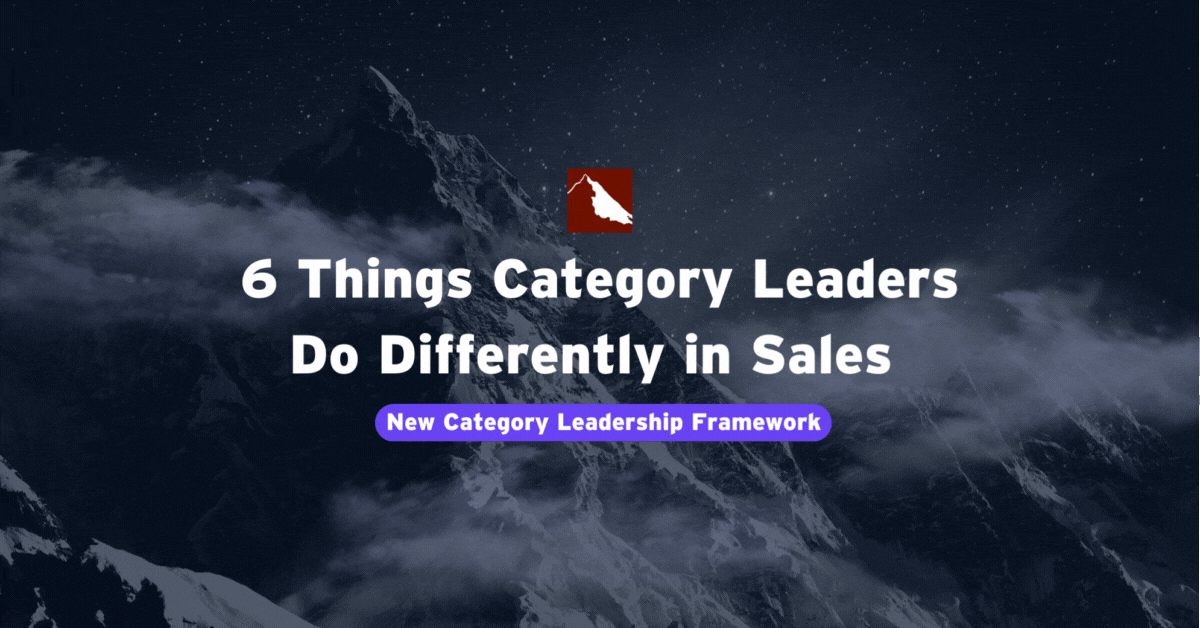What separates the 0.4% of founders who make it to $10M in ARR from the 99.6% that don’t? (Source: Nektar)
While there are many factors—market timing, macroeconomic conditions, product strategy—if I were to select one overarching differentiator, the 0.4% know how to build great sales organizations.
Of the 28 companies K1 had on the Inc. 5000 list in 2023, the common factor is sales excellence.
To sharpen your sales muscle, we interviewed some of the top operators in sales and SaaS today—including Matt Camassa (K1 Executive in Residence, fmr SVP Worldwide Sales Sift, Conversion Logic, TeleSign, Symantec), Ganesh Shankar (Founder & CEO, Responsive (formerly RFPIO)) and Drew Kiran (K1 Practice Director, Go To Market)—and identified the six things Category Leaders do differently in sales.
Prioritize Consistent Talent Acquisition
Category Leaders actively seek talent by proactively and strategically building a strong talent pool, setting ambitious yet equitable performance goals, and consistently upgrading their teams.
Ganesh Shankar, Founder & CEO of Responsive (Formerly RFPIO), shared, “Our leading position in the industry is the direct outcome of our laser focus on securing top-tier talent that not only possesses remarkable skills but also embodies our company’s ethos and values.”
Building a Talent Pool
Category Leaders understand the importance of:
- Constant Talent Search: They continually scout for potential team members, ensuring a steady talent pipeline.
- Competitive Compensation: They offer attractive compensation and benefits packages to attract and retain the industry’s best talent.
- Sales Alignment with Organizational Success: They create bonus and incentive structures tied to the organization’s goals. For instance, as a private equity firm, we incentivize based on term sheets issued, signed and closed. What drives your success?
- Recognition of Top Performers: They establish systems to recognize and reward consistent high achievers.
Leveraging Referrals and Hiring in Batches
Category Leaders also rely on referrals and batch hiring to achieve superior performance, including:
- Encouraging Referrals: They incentivize their best salespeople to recommend potential hires with a robust referral program.
- Hiring Junior Salespeople in Classes: They hire junior sales reps in groups, fostering a sense of camaraderie and competition.
- Promoting a Physical Location for SDRs and BDRs: They encourage Sales Development Reps and Business Development Reps to work from a central location, fostering a competitive and collaborative environment.
Over-Hiring to Drive Performance
Category Leaders employ the strategy of over-hiring, bringing in more talent than necessary to foster a competitive environment that motivates everyone to excel. In some cases, they may hire eight when they only need six and part ways with the lowest performers.
Invest in Training and Onboarding
In pursuing category leadership, training and onboarding is not just an option—it’s a necessity. Category Leaders recognize this critical function and prioritize it.
What Makes Effective Sales Training & Enablement
An effective sales training and enablement program is more than just a set of guidelines or brochures—it’s a dynamic, immersive and interactive process. Effective sales training isn’t easy, but it’s worth it. Most companies don’t take the time to do this well. Be the one that does.
Create sales training that is:
- Contextual: Ensure your team knows the math of the funnel and understands broader business objectives.
- Interactive: Spend time with your team answering questions, listening to concerns, and coaching them. Great enablement isn’t brochures in a Sharepoint. It’s listening to questions, fielding concerns and transferring the top 1% of behaviors to the rest of your team.
- Story-Driven: Spend quality time with your salespeople, sharing stories about what works and what doesn’t. Remember, you’re likely selling against well-known names, and these narratives can be potent tools in shaping your sales strategy.
- Enabled with Battle Cards. Create succinct, one-page summaries of your product, its advantages and how to field common objections.
- Held to Standards: Create programs to certify sales reps on your value props, use of collateral and sales processes.
Then, once you reach $25M in ARR, look to hire a Sales Excellence Professional.
The Role of a Dedicated Sales Excellence Professional
Once your ARR surpasses approximately $25 million or when you scale your sales significantly, such as hiring 10 new quota-carrying reps in a new fiscal year, it’s time to bring in a dedicated sales professional. Their primary role is to develop a curriculum aimed at improving job performance for everyone.
Additionally, this position is vital in harnessing insights from sales intelligence tools. This leads us to the sixth point.
Deliberately Align Coverage Model and Organizational Design
To claim the position of a Category Leader, your focus is growing new logo count and market share. Depending on your industry or vertical, product, and market maturity, how you work to acquire logos will differ.
The art of B2B sales lies in designing a sales organization that will best facilitate your unique go-to-market motion.
6 Classic Sales Organization Designs
Following are six of the classic sales organizational designs. Note that most companies will blend these models to suit their unique needs.
- The Triangle Model organizes reps around enterprise, mid-market, and SMB accounts. This model is effective when you have a product that works for many organizations. However, use cases and personas differ by customer size.
- The Hunter/Farmer Model uses a ‘hunter’ to find deals and passes it to a ‘farmer’ who nurtures the opportunity, as well as works on upsell/cross-sell. It works well when you have multiple products or product expansions to sell into accounts.
- The Geographical Model assigns reps based on territories and specific geographies. Companies often incorporate this into hybrid models, layering geographic territories onto verticals, products, or account tiers, when face-to-face contact drives velocity.
- The Industry Vertical Model focuses teams on specific industries like manufacturing, technology, or healthcare. It works well when a company is focused on solving a specific problem, but use cases and terminology differ by vertical industry.
- The Product Model aligns teams around a specific product within the platform. This strategy is considered as companies expand their product line, and specific products sell into specific verticals, personas, etc.
- The Persona Model aligns teams around specific buyer types. This strategy is considered when role-specific expertise helps drive sales.
Key Roles Among Category Leaders
Category-leading companies prioritize key roles and hires that often sit vacant in companies that never achieve escape velocity. These include:
- High-Performing Outbound BDRs: Invest in skilled Business Development Representatives (BDRs) who can effectively generate new business opportunities.
- Rockstar Sales or Solution Engineering Professionals: Engage top-tier sales or solution engineering professionals capable of presenting compelling solutions that boost customer confidence and drive sales performance.
- SME or Consultancy In-House (If Creating a Category): Bring top end-users or SMEs in-house as advisors to guide customer strategy and educate the market.
Extraordinary Focus on One Core ICP
In B2B sales, one strategy separates Category Leaders from the rest: an extraordinary focus on one core Ideal Customer Profile (ICP).
Companies often overlook this strategy as they try to appeal to a wide variety of customers, hedging their risk by trying to be many things to many people.
Category Leaders take a different approach. They laser-focus on a core use case rather than spreading thinly across numerous customer profiles. They obsessively work to understand their customer deeply, allowing them to sell and market their solutions more effectively than their competitors.
Matt Camassa, K1 Executive in Residence, explains, “It’s better to solve one clear problem, for one specific buyer, than to try to be all things to all people.”
This strategy might seem counterintuitive. However, without a precise understanding of your ideal customer’s industry, size and use case, you risk being overwhelmed by opportunities rather than seizing them.
Sales Practice Director Drew Kiran expands: “Category Leaders are incredibly granular in understanding their ICP. They know their buyer’s problems, goals and terminology and work relentlessly to communicate with potential customers likely to produce the most revenue. They even go as far as to say no, or adjust pricing, when accounts don’t fit their ICP as they understand not all customers are profitable and can distract from the scalable strategy.”
Smarsh is a clear example of this. Today, with its 13 appearances on the Inc 5000 list, Smarsh is laser-focused on compliance.
Early on, after gaining traction by focusing on compliance in financial services, the company made a mistake common to many fast-growth start-ups: they started to broaden their focus too soon.
By simultaneously marketing to financial services, government, healthcare, retail, e-commerce and education, Smarsh actually slowed its growth. The team righted its course and returned to focusing on compliance for financial services. This is where the big growth happened.
Smarsh founder, Steve Marsh explained, “It’s once we started to focus small that we went big.”
Align and Focus on One or Two Daily, Weekly, Monthly and Quarterly KPIs
Here’s the secret to running a Category-Leading sales team: Great leaders understand that in sales – you either hit your number or you don’t.
Category Leaders understandthis reality and use it to drive performance and accountability.
This isn’t about being harsh or unforgiving.
Like elite sports teams, top-tier sales teams are performance-driven, and leaders must assemble the best team to ensure collective success.
To achieve this, Category Leaders rigorously concentrate their teams on 1-2 vital Key Performance Indicators (KPIs) at daily, weekly, monthly, and quarterly intervals while relentlessly monitoring these metrics.
Furthermore, they continuously evaluate individual performance, seeking to upgrade their team with the right players to maintain peak performance.
The Importance of Coaching and Mentorship in Setting KPIs
If you’re a founder building your first sales team, you must recognize the importance of coaching and mentorship. One of the essential practices: When you establish your KPIs, spend time explaining the why.
For example, “We ask you to make 40 phone calls daily because we know leads will convert to SQLs at 13-26%. Of those, 50-62% will turn into opportunities, and approximately 15-30% will result in closed-won. By making 40 phone calls daily, we ensure you hit your number.”
Show them the math of the funnel. This coaching and transparency build a culture of understanding conversion rate trends and managing for the outcomes that matter.
Activity Metrics vs. Outcome Metrics
Category Leaders monitor both activities and outcomes because they recognize that a system’s output relies on its input. They often review daily activity metrics and weekly and quarterly outcome metrics to gauge effectiveness.
Finding the right balance is crucial. Avoid micromanaging your team to the point of burnout; instead, allow high performers the freedom to excel. However, do pay attention to the numbers, discern what distinguishes high performers, and strive to instill those habits and practices in the rest of your team. Here are some examples of activity and outcome metrics.
Activity Metrics:
- How many emails are the BDRs sending? How many calls?
- How many opportunities by AE? What stages are they in? Is there enough in each stage?
These leading indicators can provide a pulse check on your team’s efforts.
Outcome Metrics:
- Pipeline movement, number of deals, deal size, and revenue conversion.
- How many Marketing Qualified Leads (MQLs) from marketing?
- How many Business Qualified Leads (BQLs) from BDRs and partners?
- How are these leads converting to Sales Qualified Leads (SQLs) or opportunities?
And the most important metric: How are all those activities converting to revenue?
Remove Friction and Reduce Cycle Times—Often with Technology
Great sales leaders understand that accelerating sales requires deliberately removing friction and actively reducing cycle times whenever possible. This involves coaching, designing sales processes, and often leveraging technology.
However, it’s essential to remember that technology should serve a purpose, not just be for its own sake. Technology offers a means to organize, streamline and monitor existing processes.
Important to note: Before implementing tech solutions, it’s crucial to have a strong sales enablement or operations team in place. They ensure smooth implementation, provide training, drive adoption, and monitor KPIs for continuous improvement.
Category Leaders typically utilize the follo
- Sales Intelligence Tools (e.g., Gong or Chorus): These platforms provide insights into customer interactions, helping your team understand what works and what doesn’t in your sales conversations.
- Intent Tools (e.g., 6Sense): By identifying signals from potential customers in the decision-making process, intent tools can help your team focus efforts on the most promising leads.
- Attribution Tools (e.g., Bizible): These tools track the customer journey across multiple touchpoints, providing valuable data on which marketing strategies drive conversions.
- Messaging Tools (e.g., Lavender): Messaging tools can help streamline communication with prospects, personalizing outreach and improving response rates.





